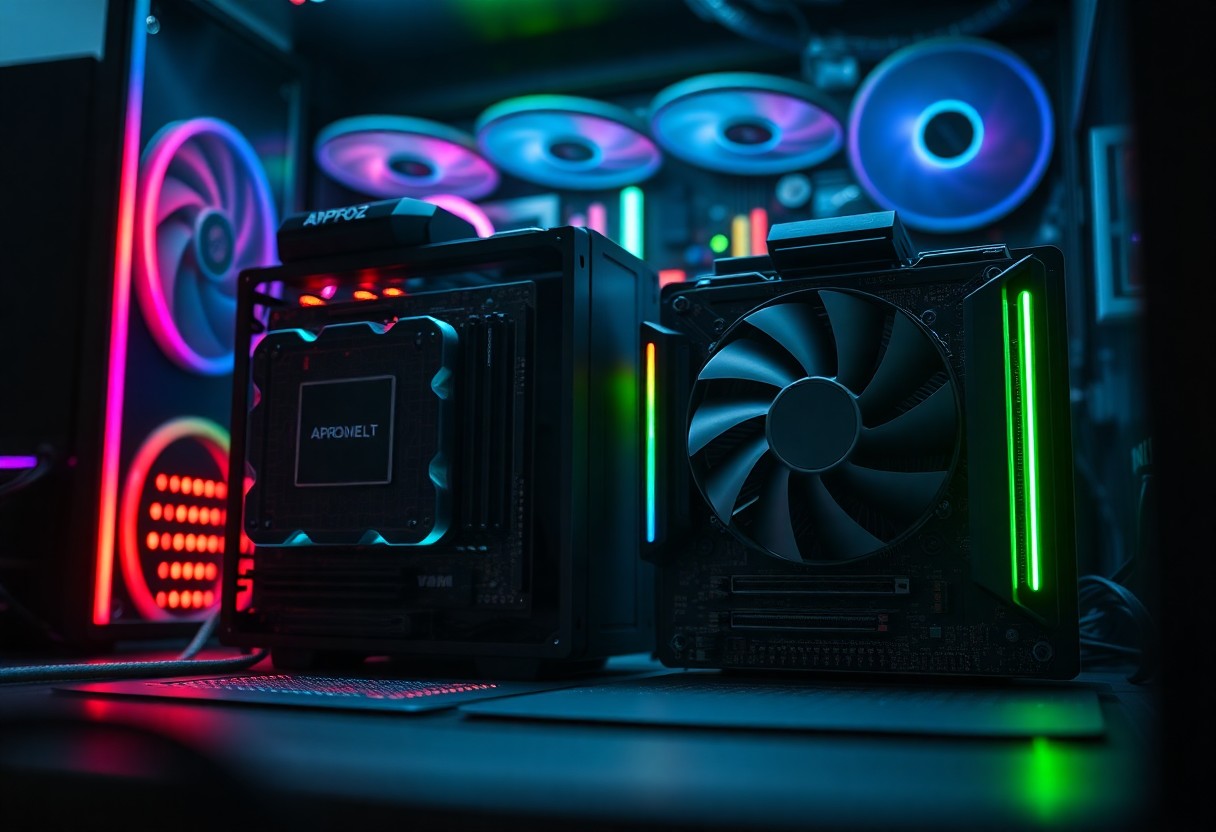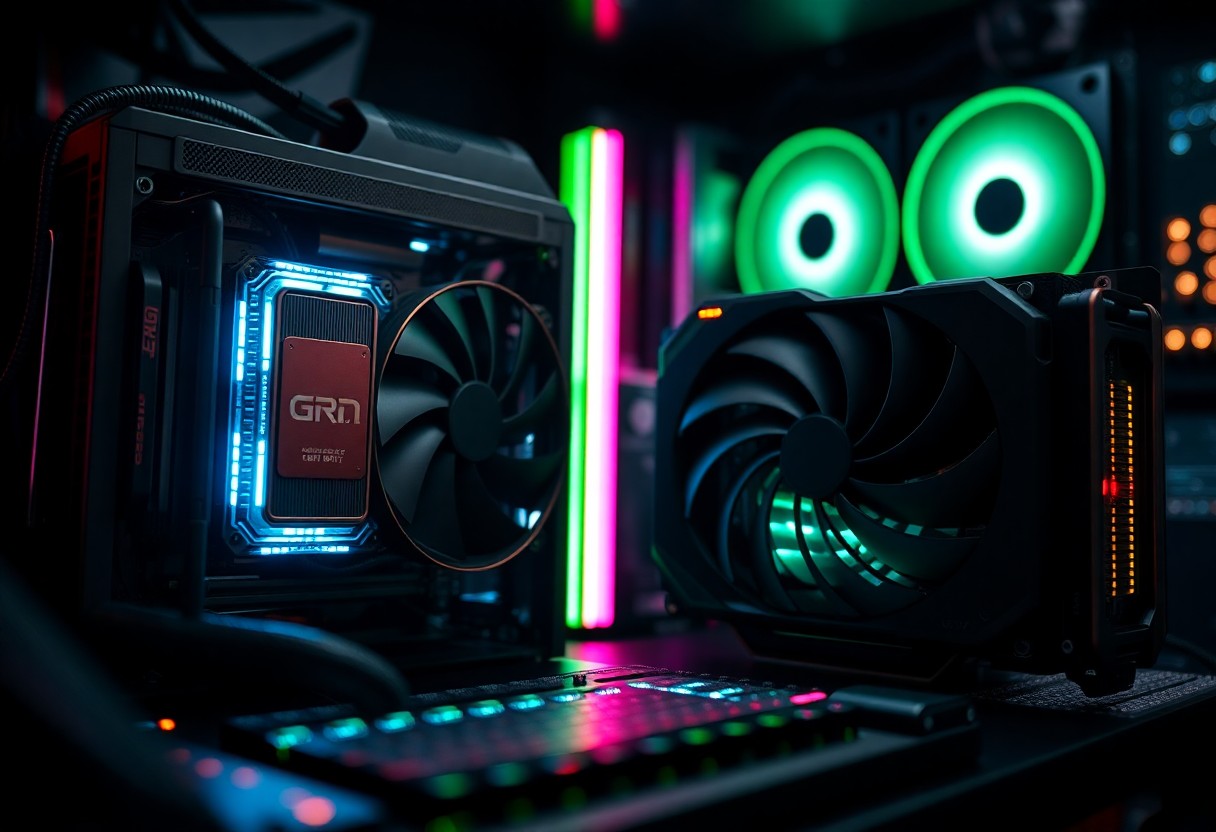PC Bottleneck Calculator
Over time, you may encounter performance limitations known as CPU or GPU bottlenecks that can hinder your gaming or computational experience. Understanding the differences between these bottlenecks is imperative for optimizing your system’s performance. If your CPU is the bottleneck, it limits your overall processing speed, while a GPU bottleneck affects graphics performance. In this post, we will explore what these bottlenecks mean, how to identify them, and the steps you can take to improve your setup for an enhanced experience.
Key Takeaways:
- Definition: A CPU bottleneck occurs when the CPU limits the performance of the system, while a GPU bottleneck happens when the graphics card restricts the frame rate and graphical output.
- Symptoms: Identifying a CPU bottleneck often involves low frame rates while seeing high GPU usage, whereas a GPU bottleneck typically shows high CPU usage with low frame rates.
- Optimization: To alleviate a CPU bottleneck, increasing the CPU’s power or upgrading to a faster processor is effective, while for a GPU bottleneck, upgrading the graphics card can provide better performance.
Understanding Bottlenecks
To fully grasp the concept of bottlenecks in computing, you need to understand how both the CPU and GPU contribute to your system’s performance. A bottleneck occurs when one component limits the performance of the entire system, preventing it from achieving its full potential. Identifying whether you are facing a CPU or GPU bottleneck will help you optimize your setup for a smoother experience.
Definition of CPU Bottleneck
Beside the overall system performance, a CPU bottleneck arises when the CPU processing power is insufficient for the tasks being executed, causing delays and reduced frame rates. This typically happens during CPU-intensive tasks like complex computations or multitasking when the CPU struggles to keep up with the demand.
Definition of GPU Bottleneck
Beside CPU issues, a GPU bottleneck occurs when the Graphics Processing Unit is unable to handle the demands of rendering graphics and visuals, leading to decreased frame rates and a subpar gaming experience. This commonly happens in graphically intensive applications, such as modern games or high-resolution video editing.
At the core of a GPU bottleneck, you may notice significant drops in frame rates, making your gaming or visual experience frustrating. The GPU struggles with rendering complex graphics, leading to stuttering and lag. Upgrading the GPU can dramatically enhance your performance, but it’s necessary to ensure your CPU can handle the increased load as well. Balancing both components is key to achieving an optimal performance level in your system.
Identifying CPU and GPU Bottlenecks
You need to discern between CPU and GPU bottlenecks to optimize your system’s performance effectively. Both components play vital roles in gaming and computing tasks, but a bottleneck occurs when one component limits the performance of another. By understanding the specific characteristics and behaviors of your hardware, you can pinpoint where the performance limitations exist and take appropriate action to resolve them.
Performance Metrics to Consider
Before venturing into diagnostics, you should analyze several performance metrics that can help you identify potential bottlenecks in your system. Key indicators include frame rate, CPU usage percentages, GPU load, and render times. Monitoring these statistics can offer a comprehensive view of how both the CPU and GPU are functioning under various workloads.
Symptoms of a Bottleneck
At times, your system may experience performance issues that indicate a bottleneck. Symptoms can include stuttering in games, low frame rates, or unresponsive applications. Such irregularities signal that one component struggles to keep up with the other, leading to inefficient performance.
Consider that high CPU usage alongside low GPU utilization typically signals a CPU bottleneck, while low CPU usage combined with high GPU load points to a GPU bottleneck. If you observe subpar frame rates despite having a powerful GPU, it can indicate inadequate CPU performance. It’s crucial to assess these signs as they can profoundly impact your overall gaming and computing experience. Addressing these symptoms promptly can lead to a more balanced and responsive system.
Factors Influencing CPU and GPU Performance
Unlike many assume, the relationship between CPU and GPU performance is influenced by various factors. These include:
- Architecture efficiency
- Thermal management
- Power consumption
- Clock speeds
- Cooling solutions
Thou must consider these factors to understand the balance and maximize your system’s performance.
Hardware Specifications
Specifications of your CPU and GPU play a significant role in their performance. The core count, clock speed, and memory bandwidth directly affect how well they perform in different tasks. A higher number of cores can benefit multithreaded applications, while a more substantial clock speed enhances single-threaded performance.
Software Optimization
Against the backdrop of hardware, software optimization is equally important in determining performance. Without proper optimization, even the best CPUs and GPUs can underperform.
Software optimizations involve fine-tuning your operating system, drivers, and applications to fully utilize your CPU and GPU. This encompasses updating drivers for the latest performance enhancements, alongside configuring game settings to you resolution and refresh rate. Neglected optimizations can lead to frame rate drops and inefficient processing. Pay attention to background applications which can consume valuable resources, hurting your overall experience. You must pursue software updates and be mindful of how your software environment impacts performance!
Measuring Performance: Tools and Techniques
For effective system performance evaluation, understanding the right tools and techniques is vital. You can pinpoint whether your setup is facing a CPU or GPU bottleneck by employing various performance measurement strategies. Metrics such as frames per second (FPS), temperature readings, and utilization percentages will guide you in identifying any shortcomings, allowing for targeted upgrades or adjustments for optimal gaming and productivity experiences.
Benchmarking Software
Any reputable benchmarking software provides a consistent way to evaluate the performance of your CPU and GPU. By using applications such as 3DMark or Cinebench, you can run tests that simulate loading scenarios and produce a score indicative of your hardware’s capabilities. This quantifiable data helps you determine if your system is operating at its full potential or if it requires an upgrade.
Monitoring Hardware Performance
Techniques for monitoring hardware performance can be vital in diagnosing bottlenecks in your system. You can use tools such as MSI Afterburner or HWMonitor to keep an eye on your CPU and GPU usage, temperatures, and fan speeds in real-time. This monitoring enables you to identify performance dips that might lead to overheating or throttling. By actively checking these metrics, you can ensure your hardware is running efficiently, leading to a more stable and enjoyable user experience.
The importance of monitoring hardware performance cannot be overstated. By keeping your system’s heat in check, you can prevent overheating that could damage components and reduce lifespan. Track your GPU and CPU usage to ensure they’re optimally utilized without hitting 100% usage, which can result in performance drops or instability. Watching for spikes in temperatures can help you prevent thermal throttling, ensuring your hardware is performing at its best for gaming or intensive tasks.

Solutions to Mitigate Bottlenecks
Not addressing bottlenecks in your system can lead to subpar performance and frustrating experiences. To mitigate these issues, you can explore various approaches. Upgrading hardware components, optimizing your settings, and tweaking game or application parameters can all contribute to a smoother and more efficient computing experience. By implementing these solutions, you can improve your system’s overall performance and enhance your productivity.
Upgrading Components
Around the world of PC build enthusiasts, upgrading components is a common practice when facing bottlenecks. Evaluating your CPU and GPU capabilities can lead you to identify which component is underperforming and may require an upgrade. Investing in a more powerful CPU or GPU can dramatically improve your system’s performance, allowing for smoother gaming and faster processing of tasks.
Adjusting Settings and Parameters
About adjusting settings and parameters, you have numerous options to enhance system performance without needing new hardware. Fine-tuning graphics settings in games or optimizing resource allocation in applications can lead to a significant decrease in bottlenecks and could maintain a consistently smoother experience.
To adjust settings effectively, consider lowering the graphics quality or resolution in demanding applications. This can reduce the workload on your GPU and allow the CPU to manage tasks more efficiently. Additionally, optimizing background processes by closing unnecessary applications can free up valuable resources, giving your system a performance boost. By regularly checking updates for your drivers and software, you take advantage of optimizations that developers often implement to enhance overall performance. Adjustments like these can significantly improve your experience while safeguarding your system from potential overheating or instability.
Real-World Examples
All hardware configurations can experience bottlenecks in different scenarios, impacting your system’s performance significantly. Understanding how your CPU and GPU interact in real-world situations is crucial for maximizing efficiency, whether you’re gaming or creating content. This knowledge allows you to optimize your setup according to your specific needs, ensuring that you get the best possible performance out of your system.
Gaming Scenarios
One common example of a CPU bottleneck occurs in fast-paced online games where your processor struggles to keep up with the high demand for calculations, resulting in lower frame rates and stuttering. In contrast, GPU bottlenecks often happen in graphically intensive games, where your graphics card is pushed to its limits, causing performance drops. Your choice of game, along with your system components, dictates which bottleneck you may encounter, and optimizing your setup can lead to a smoother experience.
Content Creation Applications
Below are various content creation scenarios where different bottlenecks can affect your workflow. For instance, video editing tasks that demand high processing power may reveal a CPU bottleneck, especially when working with large files or high-resolution content. Conversely, GPU rendering tasks can lead to GPU bottlenecks, particularly when dealing with 3D designs or using advanced effects. Understanding these dynamics ensures that you can tailor your hardware resources to best meet your specific content creation needs.
Examples of applications where you might experience a bottleneck include video editing software like Adobe Premiere, which relies heavily on CPU performance for encoding and playback. In contrast, when using rendering software like Blender, you may notice a GPU bottleneck, especially if you’re using complex shaders and high polygon counts. To maintain a smooth workflow, you need to assess how your system resources align with your specific application requirements—ensuring that neither your CPU nor GPU underperforms.
Conclusion
Now that you understand CPU and GPU bottlenecks, you can make informed decisions to optimize your gaming or computing experience. Evaluating your system’s performance and recognizing which component is limiting your capabilities allows you to take appropriate action, whether that means upgrading hardware or adjusting settings. By addressing these bottlenecks, you can enhance your overall system efficiency and ensure that your hardware functions harmoniously, maximizing the potential of your setup.

